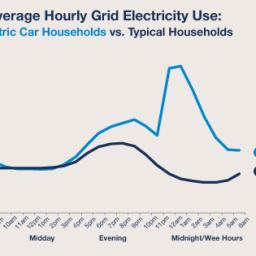This is what electric car owners are doing while you sleep
 By day: electric vehicles are taking the world by storm: their sales are doubling every year, their fuel efficiency is off the charts, and some of them can even accelerate from 0-60 mph about as fast as you can say Elon Musk.
By day: electric vehicles are taking the world by storm: their sales are doubling every year, their fuel efficiency is off the charts, and some of them can even accelerate from 0-60 mph about as fast as you can say Elon Musk.By night: the electric vehicle (EV) community continues to make waves. While you are in bed dreaming about how some day you too might own an electric car, many EV owners are doing something dramatic; something unusual; something that is reshaping the energy landscape.
They are using gobs of electricity.
Read on for some great statistics and graphs. Check out the consumption spike that occurs after dinner.
The normal household chart shows a very grid-friendly usage. It is quite even over time. The one peak and one valley are both comparatively mild and gradual.
The electric car household chart shows an extremely grid-hostile usage. If it's a few isolated households; no big deal; it is probably even a good thing. But if you get a lot of households with this same pattern, the gigantic abrupt peak at 11 pm will put an extremely heavy demand on electric energy peaking, and on the neighborhood grid wiring. Probably heavy investments will have to be made.
To the extent this peak might offset a heavy daytime peak in industrial use, this might be a partially good thing, but the article does not address this or give any related data in this connection. In any case, the ideal would be not to fight one peak with another, opposite peak. The ideal would be to minimize peaks in general.
You could do this for industry by running it 24x7 using shifts, which would be far more plant-efficient anyway.
And you could do it for electrioc car households by having two batteries that are swapped daily. The charging of the swapped-out battery would be regulated by a smart charger to deliver constant current over the 24 hour period, the value of the current being calculated to exactly reach full charge at the end of the 24 hour period.
Yes, I am aware that the customary lithium ion charging strategy is to have a constant current phase, followed by a shorter constant-voltage phase during which the current falls toward zero. So it wouldn't be quite as idealized as I described, but you could come a whole lot closer to ideal than that chart shows now.